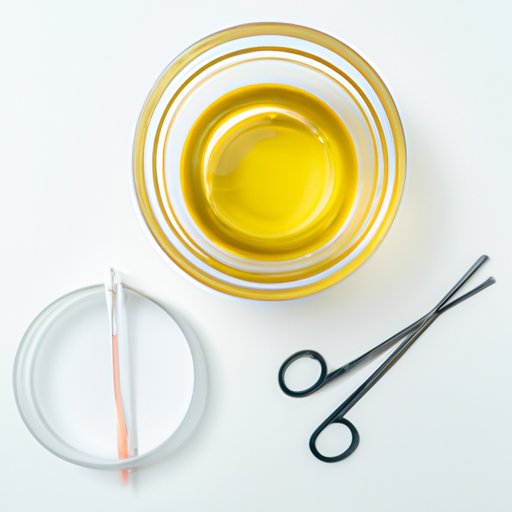
Introduction
Have you ever experienced the discomfort of earwax build-up? It’s a common problem that affects many of us, but it’s also one that needs to be addressed promptly. Earwax blockages can lead to a range of complications, including pain, infection, and hearing loss. Luckily, there are numerous methods for removing earwax from the comfort of your own home or with the help of a medical professional. In this article, we will explore the various options available for ear wax removal, including home remedies, ear drops, ear flushing, ear cleaning tools, professional cleaning, frequency of cleaning, and warning signs of wax build-up.
Home Remedies
One of the most popular ways to remove earwax is by using home remedies. These can include olive oil, hydrogen peroxide, warm water, and saltwater solution. Each method involves different steps and precautions, and some may be more effective for certain people than others.
To use olive oil, heat a small amount in a spoon, then carefully pour it into your ear using a dropper. Tilt your head to the side for a few minutes to allow the oil to soak into the ear canal. Next, tilt your head to the other side and let the excess oil drain out. Repeat on the other ear.
Hydrogen peroxide can also be used as a home remedy. Simply mix equal parts of hydrogen peroxide and warm water and use a dropper to apply the solution to your ear. Tilt your head to the side and let the solution sit for a few minutes, then drain it out by tilting your head to the other side.
Warm water can be used by itself or with a few drops of olive oil. Pour the solution into your ear and let it sit for a few minutes before tilting your head to drain it out. Saltwater solution can be made by mixing a teaspoon of salt in one-half cup of warm water. Use a dropper to apply the solution to your ear and let it sit for a few minutes before draining it out.
It’s important to note that using home remedies can carry some risks, including ear infections or damage to the ear canal if not used properly. If you experience any discomfort or increased pain, stop immediately and consult a medical professional.
Ear Drops
Another option for removing earwax is to use over-the-counter ear drops. These drops can help soften earwax before cleaning. Some of the most popular ear drops available include Debrox and Murine.
To use ear drops, tilt your head to one side and use a dropper to apply a few drops of the solution to your ear. Allow the drops to sit for a few minutes, then tilt your head to the other side to drain the solution out.
As with home remedies, there are potential risks associated with using ear drops. Some individuals may experience an allergic reaction, while others may experience increased pain or discomfort. It’s important to follow instructions carefully and stop using the drops if you experience any negative side effects.
Ear Flushing
Ear flushing can be done at home using an ear flush kit, which can be purchased at most drugstores. This method involves flushing warm water into the ear canal to remove earwax.
To use an ear flush kit, fill the bulb syringe with warm water and gently insert the tip of the syringe into your ear canal. Squeeze the bulb to allow the water to flow into your ear. Tilt your head to the side to allow the water to drain out. Repeat on the other side.
It’s important to avoid using too much pressure or too much water, which can potentially cause harm to the ear canal.
Ear Cleaning Tools
There are different types of ear cleaning tools available, including ear wax removers, ear curettes or scoops, and ear picks. These tools can be used to remove earwax from the ear canal.
Earwax removers work by breaking down earwax with a solution and then flushing it out with warm water. Ear curettes and scoops are small, spoon-like instruments that can be used to scoop out earwax from the ear canal. Ear picks are slim, pointed tools that can gently remove earwax.
It’s important to use caution when using ear cleaning tools, however, as improper use can lead to injury or further complications.
Professional Cleaning
If home remedies and ear cleaning tools are not effective, you may need to seek professional cleaning services. A medical professional, such as an ear, nose, and throat doctor (ENT), can use specialized tools to safely remove earwax from your ear canal.
It’s important to ensure that you seek services from a reputable provider to avoid complications. Additionally, some individuals may experience dizziness or pain during the procedure, and it’s important to communicate any discomfort throughout the process.
Frequency
Earwax build-up varies from person to person, but it’s generally recommended to clean ears every six to twelve months to maintain general ear health. Some people may need to clean their ears more frequently to avoid complications.
Warning Signs
There are certain warning signs that can indicate the need for more frequent ear cleaning or professional cleaning services. These can include itchiness, pain, discharge, and difficulty hearing. If you experience any of these symptoms, it’s important to seek medical attention.
Conclusion
Earwax build-up can be uncomfortable and potentially harmful if left unchecked. However, there are numerous methods available for safe removal, including home remedies, ear drops, ear flushing, ear cleaning tools, and professional cleaning. By following recommended frequencies and seeking medical attention as needed, you can maintain general ear health and avoid potential complications.





